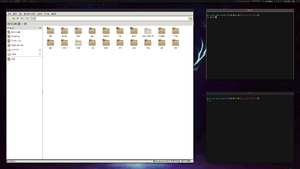xmonad
|
| |
|
xmonad in tiling mode | |
| Original author(s) | Spencer Janssen, Don Stewart, Jason Creighton |
|---|---|
| Initial release | March 6, 2007[1] |
| Stable release |
0.13[2]
/ February 10, 2017 |
| Preview release |
latest Darcs revision
/ (snapshot) |
| Development status | Stable |
| Written in | Haskell |
| Operating system | POSIX-compatible |
| Platform | Cross-platform; requires the X Window System and GHC |
| Size | 56 KB (source code)[3] |
| Available in | English |
| Type | Window manager |
| License | BSD-3 |
| Website |
www |
xmonad is a dynamic window manager (tiling) for the X Window System, written in the functional programming language Haskell.
Begun in March 2007, it is similar to dwm, larswm, StumpWM and other members of the tiling window manager family in that it arranges windows in a nonoverlapping pattern and strives to make it possible for the user to productively manage windows without the use of the mouse. xmonad is packaged and distributed on a wide range of Unix-like operating systems, such as a large number of Linux distributions, and BSD systems.
While originally a clone of dwm (derivative in areas such as default keybindings), xmonad now supports features not available to dwm users[4][5] such as per-workspace layout, tiling reflection, state preservation, layout mirroring, GNOME support and per-screen status bars; it can be customised by modifying an external configuration file and 'reloaded' while running.[6] xmonad features have begun to influence other tiling window managers - dwm has borrowed "urgency hooks" from xmonad,[7] has also included Xinerama support (for multihead displays) with release 4.8, and patches exist to reimplement xmonad's Fibonacci layout.[8]
Extensions to the core system, including emulation of other window managers and unusual layout algorithms, such as window tiling based on the Fibonacci spiral, have been implemented by the active community[9] and are available as a library.[10]
In addition to obviating the need for the mouse, the xmonad developers make heavy use of semi-formal methods and program derivation for improving reliability and enabling a total line of code count less than 1200, as of version 0.7; window manager properties (such as the behavior of window focus) are checked through use of QuickCheck. This emphasis makes xmonad unusual in a number of ways; besides being the first window manager written in Haskell, it is also the first to use the zipper data structure for automatically managing focus, and its core has been proven to be safe with respect to pattern matches,[11] contributing further to reliability. The developers write:
"xmonad is a tiling window manager for the X Window system, implemented, configured and dynamically extensible in Haskell. This demonstration presents the case that software dominated by side effects can be developed with the precision and efficiency we expect from Haskell by utilising purely functional data structures, an expressive type system, extended static checking and property-based testing. In addition, we describe the use of Haskell as an application configuration and extension language."[12]
It makes use of Haskell features and tools such as: QuickCheck, GHC extensions like pattern guards, monads, monad transformers, zippers, and the Cabal packaging system, in addition to Haskell bindings to Xlib and xft fonts (with rebinding to XCB planned when the Haskell bindings are released).

See also
References
- ↑ Earliest known release
- ↑ , HackageDB
- ↑ "xmonad : download". suckless.org. Retrieved December 17, 2012.
- ↑ "Keyboard-Driven Environments Open a New Window". OSnews. 2007-05-31. Retrieved 2007-05-31.
- ↑ "xmonad 0.4 Released". OSnews. 2007-10-19. Retrieved 2007-12-23.
- ↑ Through a combination of swiftly re-compiling and then execing the new xmonad binary; see "Haskell Weekly News: April 27, 2007". Haskell Weekly News. 2007-04-27. Retrieved 2007-05-23.
- ↑ See the developer discussion on the dwm mailing list
- ↑ Suckless.org: Fibonacci layouts patch to dwm
- ↑ xmonad users generate significant traffic in the #xmonad IRC channel and the xmonad mailing list; in addition, there are a significant number of commits to the extension library from non-core devs (see the xmonad statistic page)
- ↑ "xmonad: Contributed code". xmonad.org. 2007-05-22. Retrieved 2007-05-23.
- ↑ "Does xmonad crash? On proving pattern coverage in xmonad with Catch"; "Preconditions on XMonad"; see also "Detecting pattern-match failures in Haskell"
- ↑ Stewart & Janssen, 2007
- Notes
- Stewart, Don; Janssen, Spencer (September 2007). "XMonad: A Tiling Window Manager" (PDF). Haskell '07: Proceedings of the ACM SIGPLAN workshop on Haskell workshop: 119. ISBN 978-1-59593-674-5. doi:10.1145/1291201.1291218. Retrieved 2007-10-22.
External links
- Official website
- "xmonad - tiling window manager" - Using xmonad on Ubuntu.
- "Taste of Haskell" - OSCON presentation by Simon Peyton Jones on Haskell, using xmonad as an example
- First half of talk (video)
- Second half of talk (video)
- First half of talk on YouTube (video)
- Second half of talk on YouTube (video)
- Bits and Bytes: xmonad
- "Roll Your Own Window Manager: Part 1: Defining and Testing a Model"
- "Roll Your Own Window Manager: Tracking Focus with a Zipper"
- Haskell Communities and Activities Report - 13th edition; XMonad
- Don Stewart demo
- Comparison of extensible window managers - Comparison with sawfish, awesome, stumpWM, and qtile.
